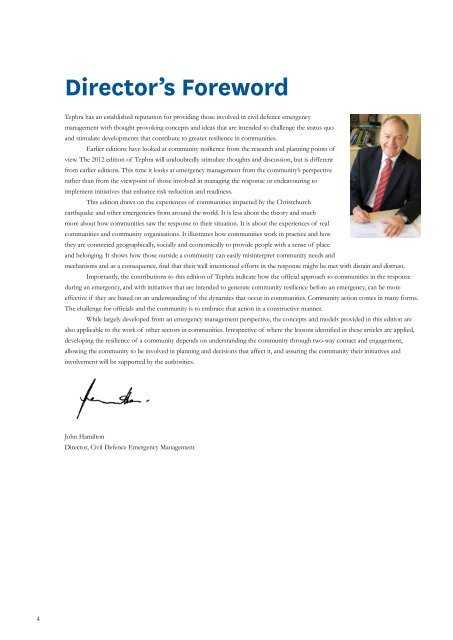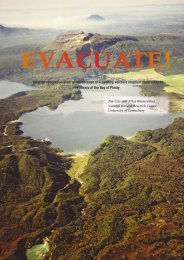Download Tephra Volume 23 (PDF, 1.33MB) - Ministry of Civil ...
Download Tephra Volume 23 (PDF, 1.33MB) - Ministry of Civil ...
Download Tephra Volume 23 (PDF, 1.33MB) - Ministry of Civil ...
You also want an ePaper? Increase the reach of your titles
YUMPU automatically turns print PDFs into web optimized ePapers that Google loves.
Director’s Foreword<br />
<strong>Tephra</strong> has an established reputation for providing those involved in civil defence emergency<br />
management with thought provoking concepts and ideas that are intended to challenge the status quo<br />
and stimulate developments that contribute to greater resilience in communities.<br />
Earlier editions have looked at community resilience from the research and planning points <strong>of</strong><br />
view. The 2012 edition <strong>of</strong> <strong>Tephra</strong> will undoubtedly stimulate thoughts and discussion, but is different<br />
from earlier editions. This time it looks at emergency management from the community’s perspective<br />
rather than from the viewpoint <strong>of</strong> those involved in managing the response or endeavouring to<br />
implement initiatives that enhance risk reduction and readiness.<br />
This edition draws on the experiences <strong>of</strong> communities impacted by the Christchurch<br />
earthquake and other emergencies from around the world. It is less about the theory and much<br />
more about how communities saw the response to their situation. It is about the experiences <strong>of</strong> real<br />
communities and community organisations. It illustrates how communities work in practice and how<br />
they are connected geographically, socially and economically to provide people with a sense <strong>of</strong> place<br />
and belonging. It shows how those outside a community can easily misinterpret community needs and<br />
mechanisms and as a consequence, find that their well intentioned efforts in the response might be met with distain and distrust.<br />
Importantly, the contributions to this edition <strong>of</strong> <strong>Tephra</strong> indicate how the <strong>of</strong>ficial approach to communities in the response<br />
during an emergency, and with initiatives that are intended to generate community resilience before an emergency, can be more<br />
effective if they are based on an understanding <strong>of</strong> the dynamics that occur in communities. Community action comes in many forms.<br />
The challenge for <strong>of</strong>ficials and the community is to embrace that action in a constructive manner.<br />
While largely developed from an emergency management perspective, the concepts and models provided in this edition are<br />
also applicable to the work <strong>of</strong> other sectors in communities. Irrespective <strong>of</strong> where the lessons identified in these articles are applied,<br />
developing the resilience <strong>of</strong> a community depends on understanding the community through two-way contact and engagement,<br />
allowing the community to be involved in planning and decisions that affect it, and assuring the community their initiatives and<br />
involvement will be supported by the authorities.<br />
John Hamilton<br />
Director, <strong>Civil</strong> Defence Emergency Management<br />
4

















